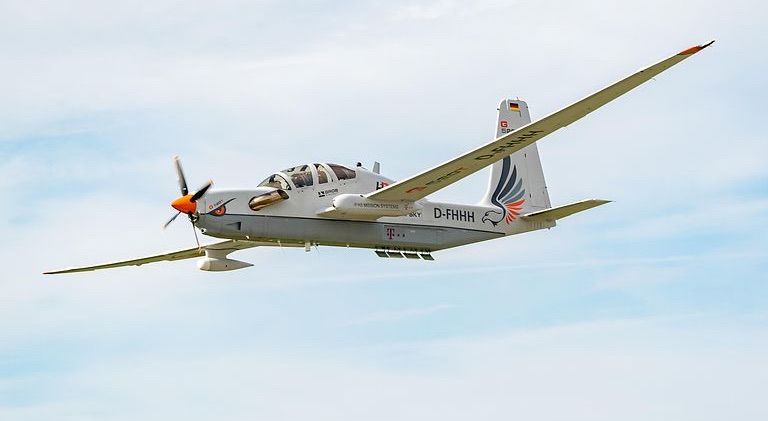The first flight tests in a project that is developing a “mega cell tower in the stratosphere” capable of delivering a 5G network from an altitude of 65,000ft (20km) for more than a week has been developed and successfully trialled in Germany during a flight test.
UK-based start-up Stratospheric Platforms Limited (SPL) is working with German communications group Deutsche Telekom and engineering firm Cambridge Consultants to develop the hydrogen-powered, remote-controlled aircraft, the associated communications payload and related ground-based infrastructure.
First flight of the High-Altitude Platform (HAP) is scheduled for mid 2022, with rollout of the first commercial service planned to begin in Germany during 2024.
Last month several test flights were carried out in Bavaria with a remote-controlled H3Grob 520 aircraft at an altitude of 46,000ft (14km) to demonstrate the flying base station concept. During the flights voice and data connections were established via the antennas installed on the aircraft, which enabled voice over LTE (VoLTE) calls, video calls, data downloads and web browsing on a standard smartphone.
During the test flights, a smartphone was connected to the terrestrial mobile network of Telekom Deutschland via the antennas on the aircraft, the first time such a connection has been made at the edge of the stratosphere and fully integrated into a commercial mobile network. The stratospheric test showed download speeds of 70Mbps and upload speeds of 20Mbps in the 2.1 GHz range over a channel bandwidth of 10MHz.
Bruno Jacobfeuerborn, member of the SPL Board on behalf of Deutsche Telekom and managing director of Deutsche Telekom’s subsidiary Deutsche Funkturm said, “We have shown that we can bring fast Internet and connectivity anywhere in the future. Particularly in areas that are difficult to access with traditional mobile masts, flying base stations will be a useful and cost-efficient addition to our mobile communications network”.
Greater 5G coverage
The HAP is designed to provide coverage over an area of up to 140km (87 miles) in diameter, the equivalent of deploying hundreds of today’s terrestrial masts, and to provide peak 5G speeds in excess of 100 Gbps in aggregate.
The HAP could provide connectivity in the developing world and fill gaps in coverage across the developed world, including rural areas. The aircraft and communications system is powered by a hydrogen fuel cell system to provide long endurance and low environmental impact with low noise, zero CO2 and zero NOx emissions.
UK-based engineering firm Cambridge Consultants is developing the communication system in partnership with SPL, including the massive antenna that the system will use.
The final antenna will cover a three-meter square area, weigh around 120kg and is expected to be the world’s largest commercial airborne communications antenna when complete and airborne. According to Cambridge Consultants the single “mega cell tower in the stratosphere” will provide coverage equal to hundreds of terrestrial cellular mast.
A proof-of-concept antenna that is around one eighth of the intended full size has been developed over the last four years. This antennae has been tested within simulated flight conditions on the ground to show that the its advanced calibration techniques can maintain performance during flight motion
Each antenna produces 480 individual, steerable beams via an array of tiles, creating patterns that can be “painted” onto the ground to cover specific areas such as roads, railway lines or shipping lanes. The capability to produce hundreds of beams enables the antenna to reuse spectrum ensuring fast and even coverage across the entire covered area.
A wholly digital beamforming capability gives massive flexibility in how services are deployed, allowing in-flight reconfiguration to deliver services beyond the reach of conventional fixed terrestrial networks. This includes following mobile users, including trains and autonomous vehicles, and providing coverage exactly where required, for example ending at national borders.
CEO of SPL Richard Deakin said, “This antenna is at the heart of SPL’s stratospheric communications system. It was essential that we overcame significant technical challenges in the design of the antenna to enable us to deliver massive data rates in a unique environment where power was limited, where weight was critical and where cooling in the thin, stratospheric air was difficult.
“The development and testing of the antenna has met or exceeded the design criteria. We look forward to continuing the journey as we progress to the production-standard antenna.”
Tim Fowler, chief sales officer at Cambridge Consultants said, “Four years ago SPL approached Cambridge Consultants with a vision to revolutionize the telecoms experience by beaming connectivity from the sky.
“Our role, to design and build this mega cell tower in the stratosphere, has seen us make breakthrough after breakthrough and we’re excited to build on these innovations with SPL, on the path to commercial deployment.”





